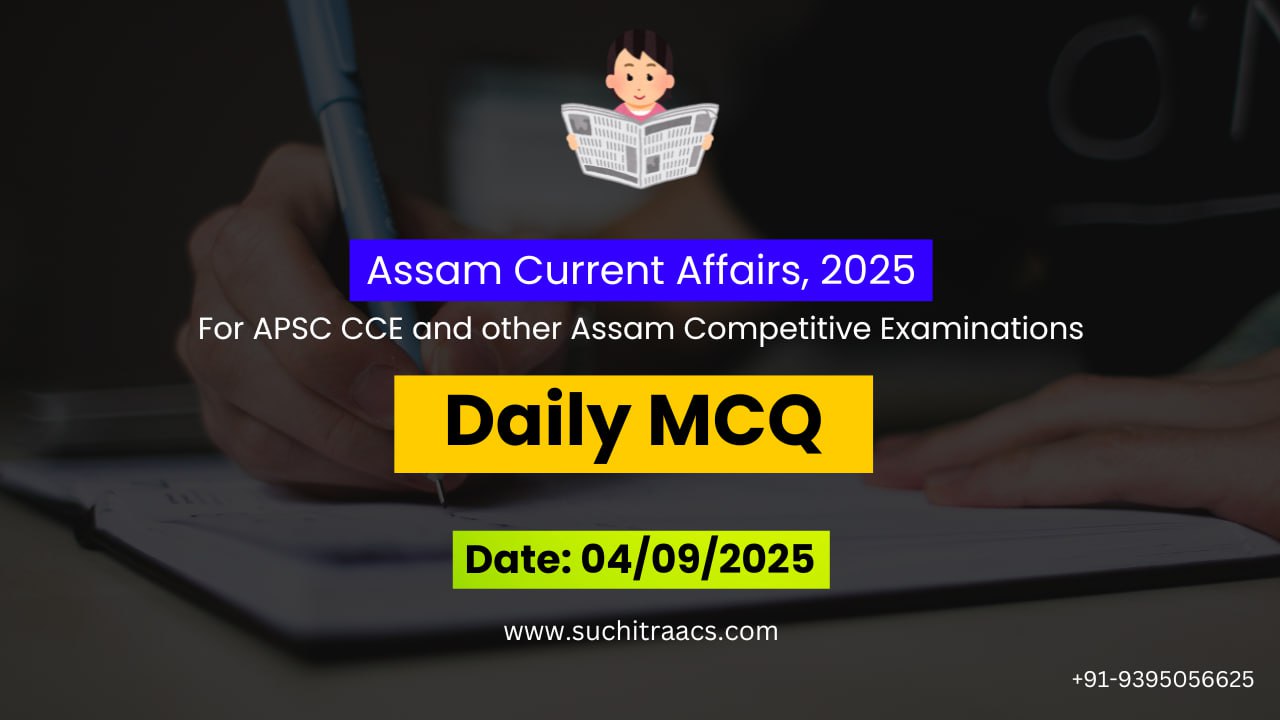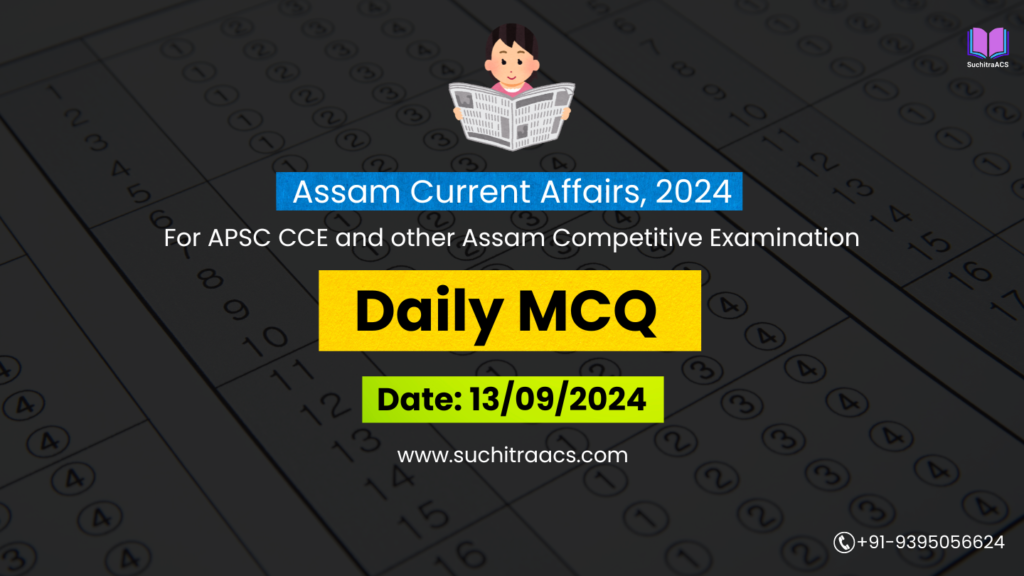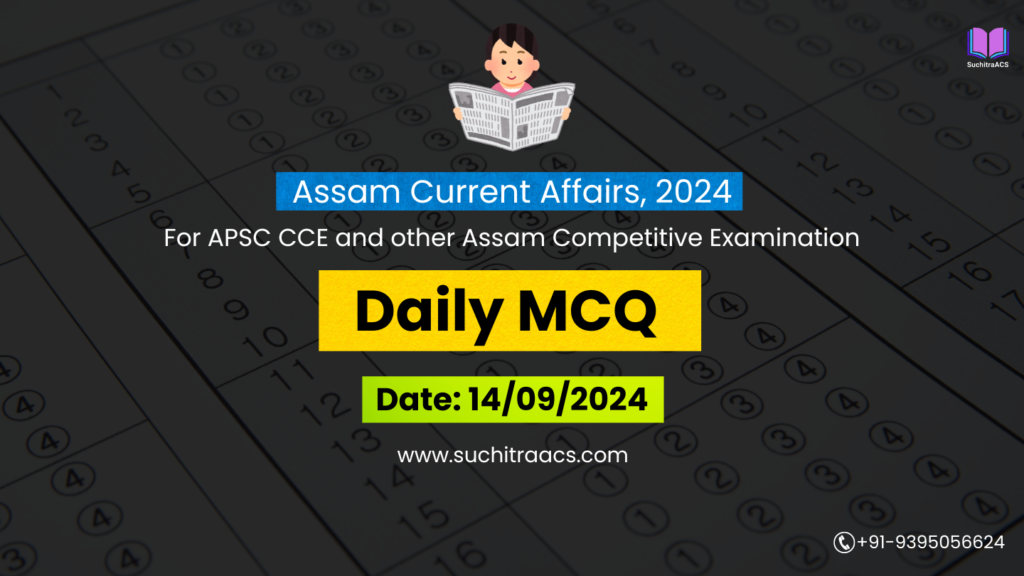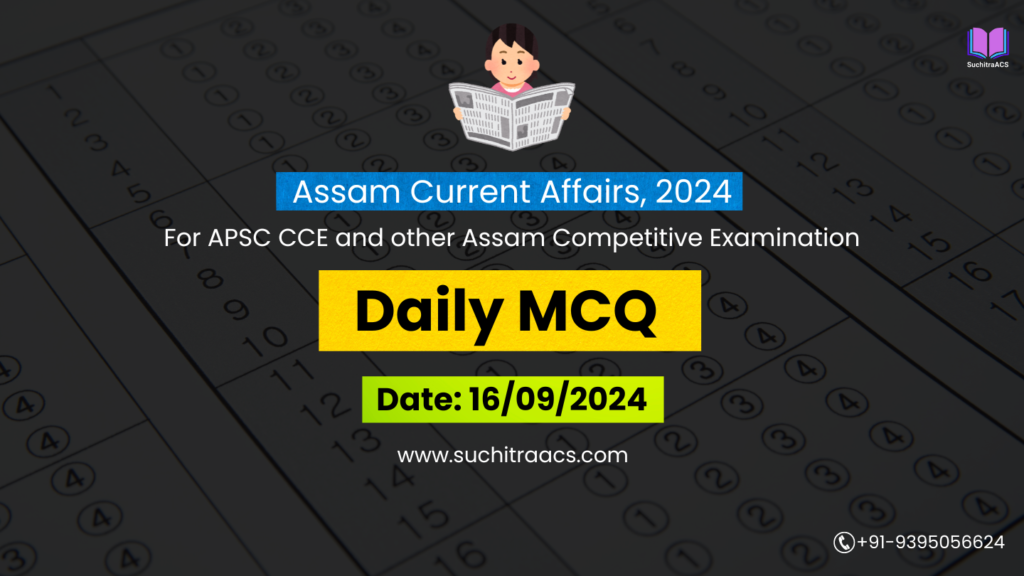APSC MCQs / APSC Prelims Practice Questions based on Assam Tribune (Daily) –05/09/2025
For APSC CCE and other Assam Competitive examinations aspirants, practicing Daily MCQs is vital. This blog covers most important Prelims questions from the Assam Tribune today (05-09-2025). These issues are key for both APSC Prelims syllabus, offering insights into the important topics of current affairs.
✨ APSC CCE Online Coaching, 2026

APSC MCQs / APSC Prelims Practice Questions (Date: 05/09/2025)
🧩 Topic 1: GST Two-Slab Reform & Assam’s Support
Q1. (UPSC – Statement type)
Consider the following statements about the Goods and Services Tax (GST):
- GST Council decisions require at least a 2/3rd majority of members present and voting.
- In the GST Council, the Centre holds 1/3rd weightage while all States together have 2/3rd.
- Assam was the first State in India to ratify the GST Constitutional Amendment Bill.
Which of the above is/are correct?
(a) 1 and 2 only
(b) 2 and 3 only
(c) 1 and 3 only
(d) 1, 2 and 3
✅ Answer: (d)
Explanation:
- GST Council voting: 75% majority needed, Centre = 1/3rd vote, States together = 2/3rd → Statements 1 & 2 correct.
- Assam was indeed the first state to ratify GST Bill (2016) → Statement 3 correct.
Q2. (UPSC – Match the pairs)
Match the following GST slabs with examples of goods/services:
| GST Slab | Example |
| A. 0% | Unbranded cereals, fresh milk |
| B. 5% | Railway passenger transport |
| C. 18% | Mobile phones |
| D. 28% | Luxury cars |
Select the correct code:
(a) A–1, B–2, C–3, D–4
(b) A–2, B–3, C–1, D–4
(c) A–1, B–2, C–4, D–3
(d) A–4, B–1, C–3, D–2
✅ Answer: (a)
🧩 Topic 2: Climate Change & Extreme Rainfall in Northeast
Q3. (UPSC – Analytical MCQ)
Extreme rainfall events in the Northeast are linked to which of the following factors?
- Increased sea surface temperature in the Bay of Bengal.
- Glacial melt in the eastern Himalayas.
- Weakening of western disturbances.
- Monsoon variability linked to El Niño and La Niña cycles.
Select the correct answer:
(a) 1 and 2 only
(b) 1, 2 and 4 only
(c) 2, 3 and 4 only
(d) 1, 2, 3 and 4
✅ Answer: (b)
Explanation:
- Bay of Bengal warming (✔), Himalayan glacier melt (✔), monsoon-ENSO variability (✔).
- Western disturbances mainly affect Northwest India, not NE rainfall → ❌.
Q4. (UPSC – Assertion-Reason type)
Assertion (A): Assam experiences annual floods affecting millions of people.
Reason (R): Nearly 40% of Assam’s land area is flood-prone due to the Brahmaputra and Barak river systems.
(a) A and R are true, and R is the correct explanation of A.
(b) A and R are true, but R is not the correct explanation of A.
(c) A is true, but R is false.
(d) A is false, but R is true.
✅ Answer: (a)
Explanation:
Floods in Assam are recurrent because ~40% of land area is flood-prone due to major river systems and heavy rainfall.
🧩 Topic 3: AI-driven Policing in Assam
Q5. (UPSC – Current Affairs factual)
Which of the following are examples of digital initiatives in Indian policing?
- CCTNS (Crime and Criminal Tracking Network System)
- ICJS (Inter-operable Criminal Justice System)
- NATGRID (National Intelligence Grid)
- PRAGATI (Pro-Active Governance and Timely Implementation)
Select the correct answer:
(a) 1 and 2 only
(b) 1, 2 and 3 only
(c) 2, 3 and 4 only
(d) 1, 2, 3 and 4
✅ Answer: (b)
Explanation:
- CCTNS, ICJS, NATGRID → directly linked to policing/internal security.
- PRAGATI → governance monitoring tool for PMO, not policing.
Q6. (UPSC – Statement type)
Consider the following with respect to predictive policing:
- It uses Artificial Intelligence (AI) and Machine Learning (ML) to forecast potential crime hotspots.
- The system has been criticised worldwide for risk of algorithmic bias.
- In India, predictive policing is already integrated into the CCTNS framework at the national level.
Which are correct?
(a) 1 and 2 only
(b) 1 and 3 only
(c) 2 and 3 only
(d) 1, 2 and 3
✅ Answer: (a)
Explanation:
Statements 1 & 2 are correct. Statement 3 is incorrect → predictive policing in India is still in pilot projects, not integrated into CCTNS.
🧩 Topic 4: Expansion of Atal Amrit Abhiyan
Q7. (UPSC – Scheme-based factual)
Which of the following disease categories were originally covered under Assam’s Atal Amrit Abhiyan (2016)?
- Cancer
- Cardiovascular diseases
- Kidney diseases
- Neurological disorders
- Burns management
Select the correct answer:
(a) 1, 2 and 3 only
(b) 1, 2, 3 and 4 only
(c) 2, 3, 4 and 5 only
(d) 1, 2, 3, 4 and 5
✅ Answer: (b)
Explanation:
Original AAA coverage = 6 categories: Cardiac, Cancer, Kidney, Neurological, Neo-natal, Burns → so correct = 1, 2, 3, 4.
Q8. (UPSC – Comparison/analytical)
Atal Amrit Abhiyan (AAA) differs from Ayushman Bharat–PMJAY in which of the following aspects?
- AAA is a state scheme of Assam, while PMJAY is a central scheme.
- AAA initially covered only selected critical diseases, whereas PMJAY provides general hospitalization cover.
- AAA provides coverage only for Below Poverty Line (BPL) families, while PMJAY includes both BPL and non-BPL households.
Which are correct?
(a) 1 and 2 only
(b) 2 and 3 only
(c) 1 and 3 only
(d) 1, 2 and 3
✅ Answer: (a)
Explanation:
(3) ❌ AAA expanded to include low-income middle class too, not just BPL.
(1) ✔ AAA = Assam scheme, PMJAY = national.
(2) ✔ AAA = critical diseases; PMJAY broader.
✨ APSC CCE Courses, 2025-26 offered by SuchitraACS


🔔 Join Our WhatsApp Study Group!
For exclusive access to premium quality content, including study materials, current affairs, MCQs, and model answers for APSC CCE and other Assam competitive exams.
Click here to join: SuchitraACS Study WhatsApp Group
📚 Want to know more about SuchitraACS’s most affordable courses?
Click here to know more: SuchitraACS Courses for APSC CCE and Assam Competitive Examinations




